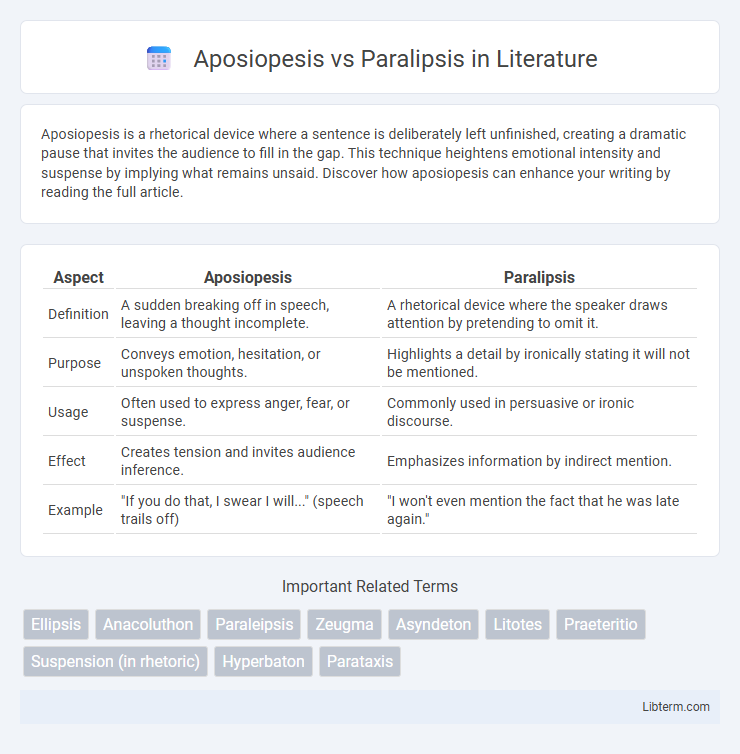Aposiopesis is a rhetorical device where a sentence is deliberately left unfinished, creating a dramatic pause that invites the audience to fill in the gap. This technique heightens emotional intensity and suspense by implying what remains unsaid. Discover how aposiopesis can enhance your writing by reading the full article.
Table of Comparison
| Aspect | Aposiopesis | Paralipsis |
|---|---|---|
| Definition | A sudden breaking off in speech, leaving a thought incomplete. | A rhetorical device where the speaker draws attention by pretending to omit it. |
| Purpose | Conveys emotion, hesitation, or unspoken thoughts. | Highlights a detail by ironically stating it will not be mentioned. |
| Usage | Often used to express anger, fear, or suspense. | Commonly used in persuasive or ironic discourse. |
| Effect | Creates tension and invites audience inference. | Emphasizes information by indirect mention. |
| Example | "If you do that, I swear I will..." (speech trails off) | "I won't even mention the fact that he was late again." |
Understanding Aposiopesis: Definition and Examples
Aposiopesis is a rhetorical device where a speaker intentionally breaks off and leaves a statement unfinished, creating an effect of emotional overwhelm or suspense. For example, in Shakespeare's "Julius Caesar," the line "Why, I-- I know not what to say" illustrates aposiopesis by trailing off abruptly. This technique contrasts with paralipsis, where the speaker emphasizes a point by pretending to omit it, making aposiopesis a distinct tool for conveying hesitation or unspeakable thoughts.
Exploring Paralipsis: Meaning and Illustrations
Paralipsis is a rhetorical device where the speaker or writer brings up a subject by explicitly stating they will not mention it, thus drawing attention to that very topic. This technique effectively emphasizes points subtly, as seen in Cicero's oratory when he claims not to criticize his opponent yet highlights their faults. Paralipsis often serves to manipulate audience perception by feigning omission while actually emphasizing the issue, distinguishing it from aposiopesis, which involves deliberate silence or breaking off mid-sentence.
Key Differences Between Aposiopesis and Paralipsis
Aposiopesis involves deliberately breaking off a sentence to create dramatic silence or tension, leaving the thought unfinished for emotional impact. Paralipsis occurs when a speaker or writer claims to omit information while actually revealing it, often to emphasize or draw attention indirectly. The key difference lies in aposiopesis's abrupt interruption to evoke unspoken meaning, whereas paralipsis uses apparent omission as a rhetorical strategy to highlight what is supposedly being ignored.
Historical Origins of Aposiopesis and Paralipsis
Aposiopesis and paralipsis both originate from classical rhetoric, with aposiopesis rooted in ancient Greek oratory where speakers intentionally break off to create dramatic effect, as seen in works by Thucydides and Homer. Paralipsis, also emerging from Greek rhetoric, was widely employed in Roman times by orators like Cicero to draw attention to a topic while professing to omit it. These rhetorical devices have evolved through centuries but remain grounded in their historical use for persuasive and impactful communication.
Functions of Aposiopesis in Rhetoric
Aposiopesis serves as a powerful rhetorical device by intentionally breaking off a sentence to evoke strong emotions, create suspense, or emphasize the unspeakable. This function allows speakers or writers to engage the audience's imagination, prompting them to fill in the missing information, often heightening dramatic effect. By strategically leaving thoughts incomplete, aposiopesis conveys hesitation, anger, or overwhelming sentiment more effectively than explicit statements.
The Role of Paralipsis in Persuasive Writing
Paralipsis strategically emphasizes a point by pretending to omit or downplay it, thereby drawing the reader's attention more powerfully than direct assertion. This rhetorical device subtly influences the audience's perception by highlighting information under the guise of restraint, making it a potent tool in persuasive writing. Effective use of paralipsis enhances argument impact through indirect suggestion, increasing engagement and memorability.
Common Usage Scenarios: Aposiopesis vs Paralipsis
Aposiopesis commonly appears in dramatic dialogue or emotional speech to convey overwhelmed feelings or abrupt interruptions, creating suspense or emphasizing unspoken words. Paralipsis is frequently used in political rhetoric and persuasive writing to draw attention to a topic while feigning omission, often to subtly highlight an accusation or point. Both devices serve strategic rhetorical functions, with aposiopesis emphasizing silence or hesitation and paralipsis manipulating audience focus through deliberate omission.
Impact on Tone and Reader Engagement
Aposiopesis creates a dramatic pause that heightens emotional intensity and invites readers to fill in the unsaid, fostering active engagement and suspense. Paralipsis strategically omits information while drawing attention to it, adding irony or emphasis that can influence the tone toward subtlety or sarcasm. Both rhetorical devices manipulate reader participation by controlling what is revealed or concealed, profoundly shaping the narrative's emotional resonance and interpretative depth.
Famous Literary Instances: Aposiopesis and Paralipsis
Shakespeare's Julius Caesar features aposiopesis in Antony's speech, where he trails off to highlight emotional intensity with unfinished thoughts. Paralipsis is famously employed by Cicero, who claims to omit certain details while subtly emphasizing them to cast doubt on political adversaries. These rhetorical devices enhance persuasive impact by either invoking the audience's imagination or strategically drawing attention to information indirectly.
Tips for Effectively Using Aposiopesis and Paralipsis in Writing
Mastering aposiopesis involves strategically breaking off a sentence to evoke suspense or emotion, allowing readers to engage their imagination. Employing paralipsis effectively requires emphasizing a point by feigning omission, which can subtly highlight key ideas without overt assertion. Balancing these rhetorical devices enhances persuasive writing by creating intrigue and reinforcing arguments while maintaining reader interest.
Aposiopesis Infographic

 libterm.com
libterm.com